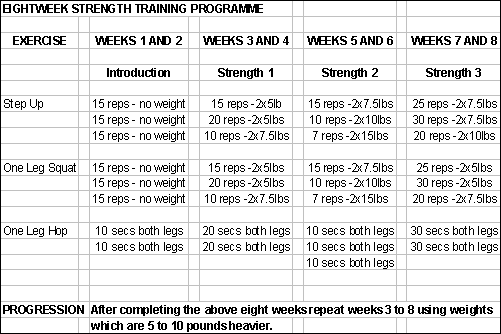| The Three Strength Exercises - Method: |
Read the strength training introduction before commencing these exercises. Warm up fully before starting the exercises: (1) High-bench step-up: Simply begin from a standing position on top of a high bench, solid chair or stool (approximately knee height), with your body weight on your left foot and your weight shifted toward the left heel. The right foot should be free and held slightly behind the body. Lower the body in a controlled manner until the toes of the right foot touch the ground, but maintain all of your weight on the left foot. Return to the starting position by driving downward with the left heel and straightening the left leg. Repeat for the prescribed number of repetitions as shown in the training table below and then switch over to the right leg. Maintain absolutely upright posture with the trunk throughout the entire movement with your hands held at your sides (with or without dumbbells). (2) One-leg squat: To complete one-leg squats in the correct way, stand with the left foot forward and the right foot back, with the feet about one shin-length apart (your feet should be hip-width apart from side to side). Place the toes of the right foot on a block or step, six to eight inches high. As in the step-up exercise, most of the weight should be directed through the heel of the left foot. Bend the left leg and lower the body until the left knee reaches an angle of 90 degrees between the thigh and lower leg. Return to the starting position, maintaining upright posture with the trunk and holding your hands at your sides. Complete the prescribed number of repetitions with the left leg before switching to the right leg. (3) One-leg hops in place: Start from the same position you used for the one-leg squat, with the toes of the right foot supported by a six- to eight-inch block. Hop rapidly on the left foot at a cadence of 2.5 to 3 hops per second (25 to 30 foot contacts per 10 seconds) for the prescribed time period as shown in the training table. The left knee should rise about four to six inches, while the right leg and foot should remain stationary. The left foot should strike the ground in the area of the mid-foot and spring upward rapidly - as though it were contacting a very hot plate on a cooker. The hips should remain level and virtually motionless throughout the exercise, with very little vertical displacement. After hopping for the indicated time on the left leg, switch to the right leg and repeat the exercise. How to Read the Following Table: Weights: Exercise Technique: |
 |
E-Mail contact: enquiries@timetrialtraining.co.uk